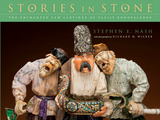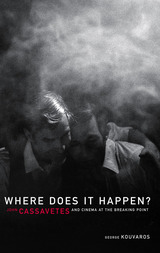3 books about 1929-1989

Stories in Stone
The Enchanted Gem Carvings of Vasily Konovalenko
Stephen E. Nash
University Press of Colorado, 2016
Vasily Konovalenko’s unique, dynamic, and theatrical sculptures stand alone in the gem-carving world—bawdy but not salacious, political but not diplomatic, boisterous and exuberant yet occasionally sensitive. Stories in Stone offers the first comprehensive treatment of the life of this little-known Russian artist and the remarkable history of his wonderful sculptures.
Part art catalogue and part life history, Stories in Stone tells the tale of Konovalenko’s impressive works, explaining their conception, creation, and symbolism. Each handcrafted figure depicts a scene from life in the Soviet Union—a bowman hunting snow geese, a woman reposing in a hot spring surrounded by ice, peasants spinning wool, a pair of gulag prisoners sawing lumber—painstakingly rendered in precious stones and metals. The materials used to make the figurines are worth millions of dollars, but as cultural artifacts, the sculptures are priceless. Author Stephen Nash draws upon oral history and archival research to detail the life of their creator, revealing a rags-to-riches and life-imitates-art narrative full of Cold War intrigue, Communist persecution, and capitalist exploitation.
Augmented by Richard M. Wicker’s exquisite and revelatory photographs of sixty-five Konovalenko sculptures from museums, state agencies, and private collections around the world, Stories in Stone is a visually stunning glimpse into a unique corner of Russian art and cultural history, the craft and science of gem carving, and the life of a Russian artist and immigrant who loved people everywhere.
Co-published with the Denver Museum of Nature & Science, home to the most significant collection of Russian gem-carving sculptures by Vasily Konovalenko in the world.
Part art catalogue and part life history, Stories in Stone tells the tale of Konovalenko’s impressive works, explaining their conception, creation, and symbolism. Each handcrafted figure depicts a scene from life in the Soviet Union—a bowman hunting snow geese, a woman reposing in a hot spring surrounded by ice, peasants spinning wool, a pair of gulag prisoners sawing lumber—painstakingly rendered in precious stones and metals. The materials used to make the figurines are worth millions of dollars, but as cultural artifacts, the sculptures are priceless. Author Stephen Nash draws upon oral history and archival research to detail the life of their creator, revealing a rags-to-riches and life-imitates-art narrative full of Cold War intrigue, Communist persecution, and capitalist exploitation.
Augmented by Richard M. Wicker’s exquisite and revelatory photographs of sixty-five Konovalenko sculptures from museums, state agencies, and private collections around the world, Stories in Stone is a visually stunning glimpse into a unique corner of Russian art and cultural history, the craft and science of gem carving, and the life of a Russian artist and immigrant who loved people everywhere.
Co-published with the Denver Museum of Nature & Science, home to the most significant collection of Russian gem-carving sculptures by Vasily Konovalenko in the world.
[more]

The Visceral Screen
Between the Cinemas of John Cassavetes and David Cronenberg
Robert Furze
Intellect Books, 2015
Narrative and spectacle describe two extremes of film content, but the oeuvres of John Cassavetes and David Cronenberg resist such categorization. Instead, Robert Furze argues, the defining characteristic of these directors’ respective approaches is that of “visceral” cinema—a term that illustrates the anxiety these filmmakers provoke in their audiences. Cassavetes demonstrates this through disregard for plot structure and character coherence, while Cronenberg's focus is on graphic depictions of mutilation, extreme forms of bodily transformation, and violence.
The Visceral Screen sets out to articulate alternative ways of appreciating film aesthetics outside the narrative/spectacle continuum. Cassavetes and Cronenberg are established auteurs, but the elements of their films that appear to be barriers to their artistic status—for example, slipshod method and lingering violence or pre-digital special effects—are reassessed here as other indicators of creativity. In this way, Furze encourages debates of what makes a film good or bad—beyond how much it is seen to adhere to particular, established models of filmmaking.
The Visceral Screen sets out to articulate alternative ways of appreciating film aesthetics outside the narrative/spectacle continuum. Cassavetes and Cronenberg are established auteurs, but the elements of their films that appear to be barriers to their artistic status—for example, slipshod method and lingering violence or pre-digital special effects—are reassessed here as other indicators of creativity. In this way, Furze encourages debates of what makes a film good or bad—beyond how much it is seen to adhere to particular, established models of filmmaking.
[more]

Where Does It Happen
John Cassavetes And Cinema At The Breaking Point
George Kouvaros
University of Minnesota Press, 2004
“A good movie,” John Cassavetes has remarked, “will ask you questions you don’t already know the answers to.” And in his films, Cassavetes is as good as his word. Taking up the radical question that Cassavetes’s films consistently pose—specifically, where is the line between actor and character, fiction and reality, film and life?—George Kouvaros reveals the unique and illuminating position that Cassavetes’s work occupies at the intersection of filmmaking and film theory.Central to any understanding of Cassavetes’s achievement is the issue of performance. Looking at the work of Gena Rowlands, Ben Gazzara, and Cassavetes himself in films such as Faces, A Woman under the Influence, and The Killing of a Chinese Bookie, Kouvaros shows how performative instances—gestures, words, or glances—open up intimations of dramas belonging neither strictly to these films nor to the everyday worlds in which they are immersed. A major reassessment of the filmmaker as a formal experimenter, Where Does It Happen? gives Cassavetes his due as a filmmaker whose critical place in the modern cinema is only now becoming clear. George Kouvaros is senior lecturer in the School of Theatre, Film, and Dance at the University of New South Wales, Australia.
[more]
READERS
Browse our collection.
PUBLISHERS
See BiblioVault's publisher services.
STUDENT SERVICES
Files for college accessibility offices.
UChicago Accessibility Resources
home | accessibility | search | about | contact us
BiblioVault ® 2001 - 2024
The University of Chicago Press









